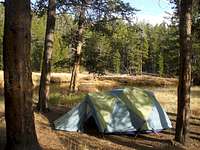-
 21607 Hits
21607 Hits
-
 78.27% Score
78.27% Score
-
 9 Votes
9 Votes
|
|
Mountain/Rock |
|---|---|
|
|
42.76220°N / 109.1871°W |
|
|
Fremont |
|
|
Hiking, Scrambling |
|
|
Summer, Fall |
|
|
12488 ft / 3806 m |
|
|
Overview
An oft-overlooked mountain...Dog Tooth Peak is the middle and highest of three mountains that sit on the Continental Divide northeast of Big Sandy Lake in the Wind River Range of Wyoming. These mountains are located in Bridger Wilderness, within the 3.4 million-acre Bridger-Teton National Forest. To the northwest is Mitchell Peak and to the southeast is Big Sandy Mountain.
From Big Sandy Lake, Dog Tooth Peak appears as a nondescript hump of talus, and in fact most of the mountain is a steep pile of boulders. The east side of the mountain, however, drops off precipitously to Papoose Lake and North Popo Agie River Basin.
On the summit plateau are two boulder-strewn hills; the northernmost hill is the highest point and true summit. The views from here include Mitchell Peak and Cirque of the Towers to the north/northwest, and the impressive Point 11,320 and Big Sandy Mountain to the south.
Even if you are alone on this mountain, chances are good that you will encounter some wildlife, such as mule deer, grizzlies, black bears, moose, elk, bighorn sheep and of course squirrels, pikas and chipmunks.
Getting There
Access is from the Big Sandy Trailhead, which requires 20-40 miles of driving on dirt roads from the south, west or north. For detailed directions and information about Big Sandy Trailhead, click here.From the trailhead, follow the Meeks Lake / Big Sandy Trail six miles to Big Sandy Lake. This section of trail is mostly easy walking and often used for horseback riding. It requires very little elevation gain as it weaves through scenic wilderness meadows and forests alongside the Big Sandy Creek.
From Big Sandy Lake, Dog Tooth Peak is evident between Mitchell Peak and Big Sandy Peak, to the north. From the lake, there are a couple of route options for Dog Tooth Peak, which are described below. No trails lead to the summit, so any route to the summit requires a wilderness bushwhack.
Route Options
The most aesthetic route to the summit of Dog Tooth Peak requires a class 3 bushwhack up the northwest slopes of the mountain to the north ridge.Another option is the southeast slopes, which also requires extensive bushwhacking and possibly some scrambling.
From any route, total round-trip distances are between 14-16 miles with about 3,300 feet elevation gain.
Red Tape
There are no fees or restrictions for hiking or camping within the Bridger Wilderness or Bridger-Teton National Forest--except for $8 to camp between June 20 and September 10 at the trailhead. Practice Leave No Trace and beware of grizzlies.Camping
The Big Sandy Trailhead is a popular destination for hikers and climbers during the summer. From there one can access several lakes, plus the fantastic climbing destination of the Cirque of the Towers. There are 12 camping spots available at the trailhead, with a pit toilet. No water is available aside from the creek flowing by the campground, which must be filtered.Also, camping is allowed anywhere along the routes to Dog Tooth Peak. The mountain can be climbed in one day, or one can choose to hike to near Big Sandy Lake and camp in that area before attempting the mountain, to break up the mileage.
Remember, this is bear country! Store and hang food away from tents and camping areas.
External Links
Add External Links text here.Bridger Wilderness
Bridger-Teton National Forest






